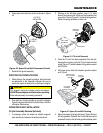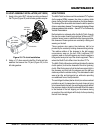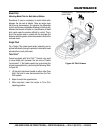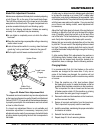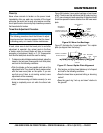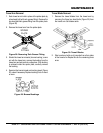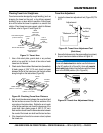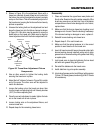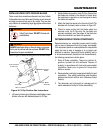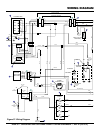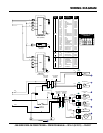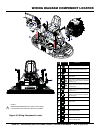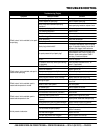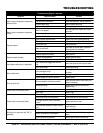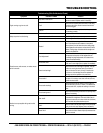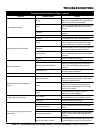
JWN-SERIES RIDE-ON POWER TROWEL • OPERATION MANUAL — REV. #1 (05/12/12) — PAGE 35
INSTALLING PANS ONTO FINISHER BLADES
These round discs sometimes referred to as “pans” attach
to the spiders arms and allow early floating on wet concrete
and easy movement from wet to dry areas. They are also
very effective in embedding large aggregates and surface
hardeners.
Refer to Figure 36 when installing pans onto finisher blades.
Figure 36. Z-Clip Finisher Pan Instructions
1. Lift trowel just enough to slide pan under blades. Lower
finisher onto pan with blades adjacent to Z-Clips.
WARNING
Lifting/Crush Hazard. DO NOT lift trowel with
pans attached.
WARNING
ALWAYS install pans either on the work area or on an area
that is next to and level with the work area. DO NOT lift the
trowel when the pans are attached.
Blade
Assembly
Knob,Tie-Down
Z-Clip Pans
Tie-Down,
Blade
Z-Clip Pan
2. Rotate blades into position under Z-Clips. Ensure that
the blades are rotated in the direction of travel when
the machine is in operation or use the engine to rotate
the blades into position.
3. Attach the blade tie-downs to the far side of the Z-Clip
brackets with tie-down knobs as shown in Figure 36.
4. Check to make certain that the blade edges are
secured under the Z-Clips and the tie-downs are
secured completely over the edges of the blade bar
before the machine is put back into operation.
DECOMMISSIONING TROWEL/COMPONENTS
Decommissioning is a controlled process used to safely
retire a piece of equipment that is no longer serviceable.
If the equipment poses an unacceptable and unrepairable
safety risk due to wear or damage or is no longer cost
effective to maintain, (beyond life-cycle reliability) and is
to be decommissioned, (demolition and dismantlement),
the following procedure must take place:
1. Drain all fluids completely. These may include oil,
gasoline, hydraulic oil and antifreeze. Dispose of
properly in accordance with local and governmental
regulations. Never pour on ground or dump down
drains or sewers.
2. Remove battery and bring to appropriate facility for lead
reclamation. Use safety precautions when handling
batteries that contain sulfuric acid, (Reference Setup
Section).
3. The remainder can be brought to a salvage yard or
metal reclamation facility for further dismantling.
MAINTENANCE



